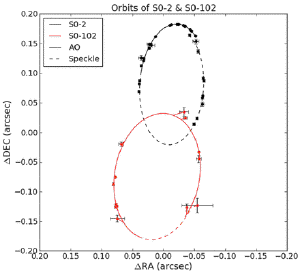Post
A Short Period
5 October 2012
In the center of our galaxy, only 27,000 light years away, lies a supermassive black hole. Some of the strongest evidence of this black hole is the observation of stars closely orbiting it. I’ve plotted the orbits of a few of these in an earlier post. At the time, the star with the shortest orbital period was S0-2, with a period of about 15.5 years. Today in Science1 a new star, S0-102, was announced with an period of 11.5 years. You can see a plot of this new star in the figure below.
 Meyer, L., et al.
Meyer, L., et al.Two things make this announcement interesting. The first is that it is part of a process of discovering more stars orbiting the supermassive black hole. Observing these stars is hard, because they are obscured from our direct view by gas and dust surrounding the center of our galaxy. We have to infer their positions by infrared and radio observations. Until recently we’ve only been able to get good measurements on the brightest of these stars. However by observing the motion of the bright stars we’ve been able to determine the mass of the supermassive black hole fairly well. This means we can use its mass to predict the motion of orbiting stars. These predictions allow us to refine observations of dimmer stars such as S0-102. By observing brighter stars we can find dimmer stars with confidence.
The second interesting aspect is that they provide an observational test of general relativity. Stars such as S0-2 and S0-102 orbit the black hole so closely that their orbits should precess due to the curvature of space and time. Given the shortness of their periods, we should be able to observe this precession directly.
Of course the most interesting aspect is that we can actually watch stars falling around a black hole. How cool is that?
Meyer, L., et al. “The shortest-known–period star orbiting our galaxy’s supermassive black hole.” Science 338.6103 (2012): 84-87. ↩︎